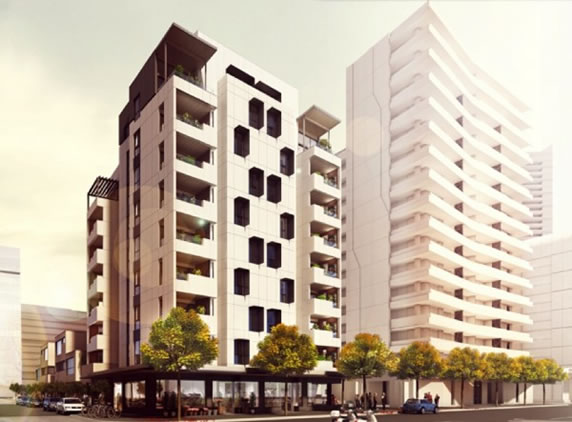
Forte, an apartment building located in Melbourne, Australia, is the tallest timber apartment building in the world. The project is being developed by Lend Lease Corp. which also developed the Sydney Opera House and had a hand in the Petronas Towers—the World’s Tallest Skyscrapers from 1998 to 2004. The wooden structural members are cross-laminated timber (CLT). Because of its high density, CLT is not very flammable, but the designers kept the wood mostly hidden, perhaps to ease resident’s flammability fears. (Rendering: Lend Lease Group)
Recent architectural trends have involved the use of engineered wood as a structural material for increasingly tall buildings. The buildings, which are cited for their advantages in sustainability resulting from the use of a renewable construction material, are constructed from wood products including cross laminated timber (CLT), laminated veneer lumber (LVL), or glued laminated timber (Glu-lam).
Construction is currently underway on Forte, a 10-story wooden apartment building in Melbourne, Australia, with taller structures up to 30-stories being designed in Norway, Austria and Vancouver. Claims have been made that they are designed to be safer than buildings fabricated using structural steel due to the formation of an insulating char layer that forms on the perimeter of a laminated wood beam when exposed to a fire. The Fire Protection Research Foundation, an affiliate of the National Fire Protection Association (NFPA), decided to investigate these claims.
The investigative team’s resulting report was recently released titled, “Fire Safety Challenges of Tall Wood Buildings.” The report’s goal was to “shed light on the performance of tall wood buildings under credible fire scenarios to ensure the safety of the occupants against emissions and thermal hazards, as well as the property protection of the building and nearby structures.” The first phase was to gather information and data from relevant studies and analyze the knowledge gaps. In addition, a framework prioritization of research needs was produced.
According to the report, the development of engineered wood products has introduced the possibility of constructing wooden high-rises. Wood is once again becoming a desirable construction material as international architects tout its sustainability benefits. Though sometimes called “woodscrapers,” the buildings are usually referred to as tall timber buildings (six-stories or greater). These include high-rise designs that attempt to maximize the use of timber as a renewable resource and often feature exposed timber elements throughout the structure. Some proposed designs explore the potential to reach heights in excess of 30-stories. However, as a combustible material, one of the biggest barriers to construction of tall timber buildings is the potential fire risk resulting from the combustible structure.

Currently under development in Kirkenes, Norway, Barents Secretariat Tower would be the tallest timber structured building in the world. Reiulf Ramstad Architects, working in close collaboration with engineers and specialists in construction and fire safety, have concluded that the project is technically possible. The construction consists of a system of columns and beams using glue laminated timber (glu-lam), with diagonal elements for stability. The massive floor beams are made of cross laminated timber (CLT). (Rendering: Reiulf Ramstad Architects)
These buildings present ambitious designs for the future vision of tall timber structures, but designers are currently limited by prescriptive code legislation. These codes restrict the potential for tall timber buildings based on the issues of structural and fire safety, as height and area limitations restrict use. As knowledge and understanding of fire and timber buildings develops, the potential for regulatory change becomes increasingly possible, according to the report.
While the study focused on characterizing the fire safety challenges and gaps in knowledge for tall timber buildings, the researchers observed a challenge regarding the perception of fire safety in tall timber buildings. This primarily includes perceptions from society as expressed through the building codes. These perceptions can be affected by a number of concerns, some emotional, from unfamiliarity to dread of catastrophe. These sentiments about living, working and occupying tall buildings that are combustible by nature could affect the acceptance of this type of building. There is very little written on the subject of public perceptions and the building regulatory process, with even less available solely on the subject of timber or high-rise construction.
The Fire Protection Research Foundation report reccomends that more research and testing be done, including fire testing of new timber and hybrid solutions and large-scale fire testing of mock-up tall timber frames. “Ultimately, research, fire testing and greater experience with combustible construction will increase the understanding of fire safety in tall timber buildings. It is the effective communication of this understanding that is critical to demonstrate fire safety in timber buildings and support change in the regulatory environment,” the researchers state.

